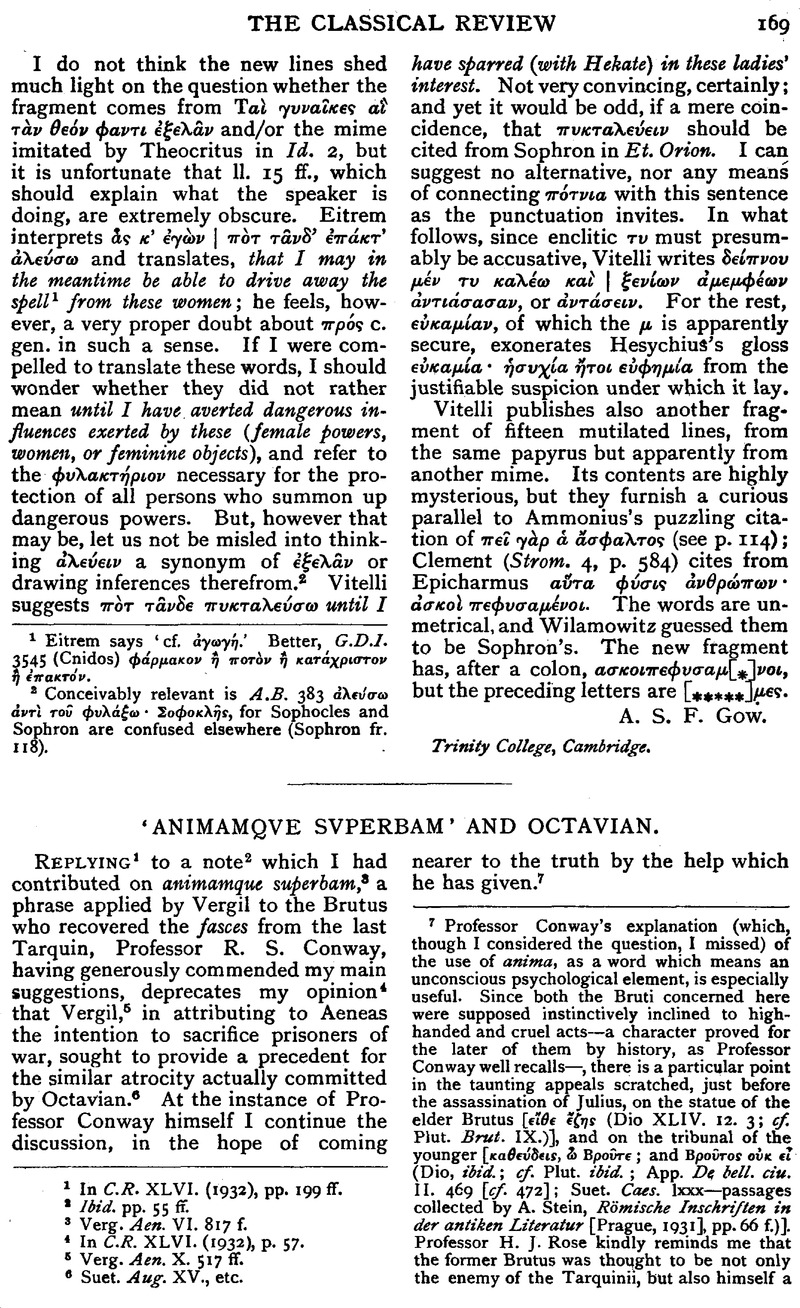No CrossRef data available.
Article contents
‘Animamqve Svperbam’ and Octavian
Published online by Cambridge University Press: 27 October 2009
Abstract

- Type
- Review Article
- Information
- Copyright
- Copyright © The Classical Association 1933
References
page 169 note 1 In C.R. XLVI. (1932), pp. 199 ff.Google Scholar
page 169 note 2 Ibid. pp. 55 ff.
page 169 note 3 Verg, . Aen. VI. 817 f.Google Scholar
page 169 note 4 In C.R. XLVI. (1932), p. 57.Google Scholar
page 169 note 5 Verg, . Aen. X. 517 ff.Google Scholar
page 169 note 6 Suet. Aug. XV., etc.
page 169 note 7 Professor Conway's explanation (which, though I considered the question, I missed) of the use of anima, as a word which means an unconscious psychological element, is especially useful. Since both the Bruti concerned here were supposed instinctively inclined to high-handed and cruel acts—a character proved for the later of them by history, as Professor Conway well recalls—, there is a particular point in the taunting appeals scratched, just before the assassination of Julius, on the statue of the elder Brutus [εἴθε ἔζης (Dio XLIV. 12. 3; cf. Plut. Brut. IX.)], and on the tribunal of the younger [καθεδεις, ὠ Βροτε; and Βροτος οὐκ εἰ (Dio, ibid.; cf. Plut. ibid.; App. De bell. ciu. II. 469 [cf. 472]; Suet. Caes. lxxx—passages collected by A. Stein, Römische Inschriften in der antiken Literatur [Prague, 1931], pp. 66 f.)]. Professor H. J. Rose kindly reminds me that the former Brutus was thought to be not only the enemy of the Tarquinii, but also himself a Tarquin on his mother's side (Liv. I. 56. 7), so that it was the more natural for Vergil to classify both Brutus and the last Tarquin together as tyrannical.
page 170 note 1 The ‘precedent’ was ‘legendary’ in a full sense; I do not mean of course that it was designed as an example to be followed, or that the deed was to be sanctioned by any reverence due to antiquity. Clearly, in the past of poetry, evil and good are both idealized and magnified. The legendary quality seems to me to make the parallel more remote from common experience, so that even the comparison between the act of Octavian and the intention of Aeneas need not be obvious.
page 170 note 2 I was careful to say ‘… since Octavianus had sacrificed human beings, Aeneas must certainly … be ready to do so too’ [in C.R. XLVI. (1932), p. 57]Google Scholar, not ‘… must certainly do so too.’
page 170 note 3 Conway, R. S., Vergil's Creative Art (London, 1930), pp. 12 ff.Google Scholar
page 170 note 4 I attach considerable importance to the indication given by Seneca, who (De Clement. I. xi. 1), writing of the perpetration of human sacrifice, says that Augustus hated the memory of his crime and was a very different man in later years.
page 170 note 5 In C.R. XLVI. (1932), p. 201Google Scholar, where he refers to Vergil's opinion of the impia saecula, and his conviction that when men act so, disaster must always follow.
page 170 note 6 Tarn, W. W. in J.R.S. XXI (1931), pp. 173 ff.Google Scholar, especially 182 f., 196 ff.; cf. Tarn in C.Q. XXVI. (1932), pp. 75 ff.Google Scholar, especially p. 80 note 10 cont. p. 81, and p. 81. Cf. Suet. Claud. XLI.
page 171 note 7 Professor Conway's view of ‘the power which genius has of penetrating to the truth and stamping it on other men's minds’ seems to me incontrovertible. He has surely proved it, for Vergil's power over Octavian, in Poetry and Government (Manchester, 1928), especially pp. 6 ff., 19 ff. Neither Shakespeare (to whom Professor Conway refers) nor Vergil (although his poetry is ‘allegorical’ in some sense in which Shakespeare's is not) approved of the crimes of their characters. On the other hand, it may be misleading to consider whether an artist intends us to admire his characters as moral individuals or not [G. Wilson Knight, The Imperial Theme (London, 1930), pp. 19 ff., etc.]. Probably in the most relevant sense Vergil's Aeneas, Dido, Turnus and Allecto are all equally admirable. The artist himself does not argue; and, in the category of pure art a sin seems rather something to be understood than something to be condemned, for in this category condemnation is pointless. Vergil in particular takes us to ‘a world where it would be strange not to forgive.’ I do not argue, of course, that artists are without approval or disapproval for the actions of their characters, and still less do I suggest that moral facts are not of the utmost importance in art. According to Croce, a work of art is a creative representation of ‘a world desired or a world abhorred’ by the artist. But the artist allows the ethical colour, which, for him, his material bears, to emerge from the vital essence which he himself instils into that material. He does not overlay the ethical colour extrinsically. In the incident of the prisoners of war Vergil shows by his artistic treatment that even after terrible thoughts Aeneas can be forgiven; and Octavian might if he chose be reassured that, though he himself had actually fallen to temptation, there could be forgiveness for him also.
P.S.—This note was in proof when Professor Conway died. I leave it as it was, because he had seen it, and liked it. But I cannot help mentioning here the reverence for him and the sorrow which I share with many, and my own immense debt both to his boundless personal kindness and to his work.
Multis ille bonis flebilis occidit, nulli flebilior quam tibi, Vergili.




